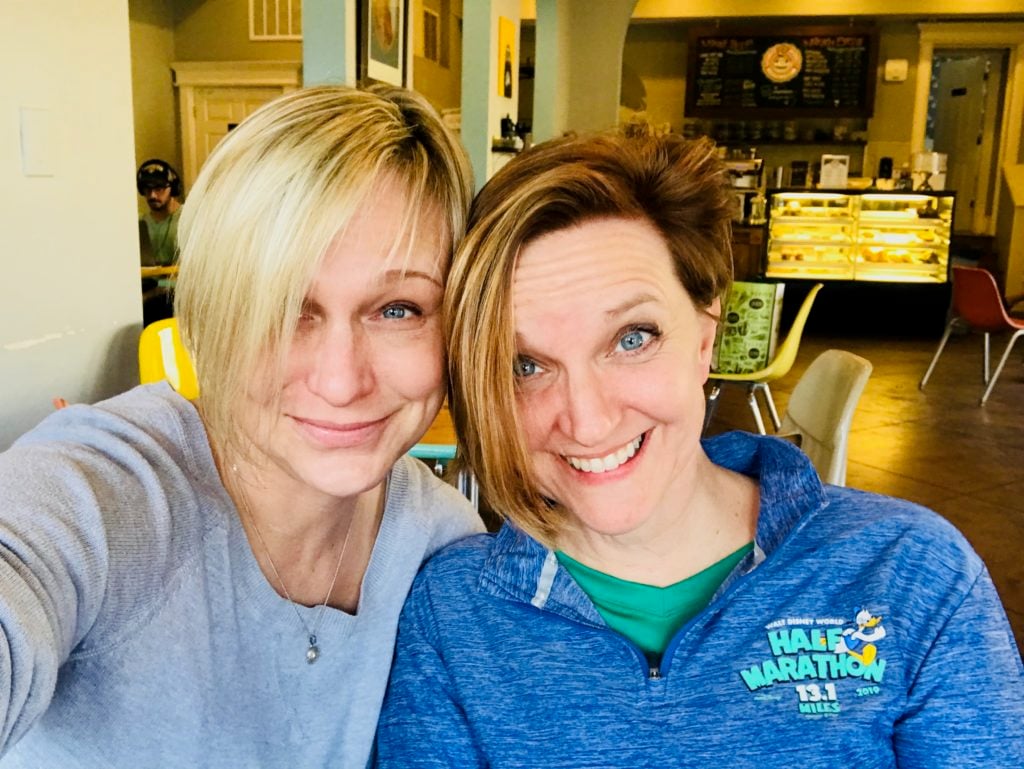15 years of this running journey, and I find myself at a new point.
In 2004, I was making it up as I went along, trying to figure out how to train for a my first triathlon (basically, I didn’t). Learned the lessons. Made mistakes. Learned more lessons. As I went along, I discovered the beauty of the training plan…any training plan — taking the guesswork out of how to reach a goal. I learned lessons there, too. Still later, I decided to take my journey to the next level and hire or follow coaches, most notably Coach Christine Hinton, who has helped me break personal records even 15 years into my fitness journey. I’ve learned so much about myself as an athlete, and now, as a coach, the learning curve is even steeper.
And now, I’m flying solo again. As one of her client athletes, I always feel Christine keeps me honest, but for the next year or two, she is stepping away from her coaching to focus on her personal and professional development (and I couldn’t be more excited for her). That means, though, that for the first time in 15 years, I’m learning to coach myself — making it up all over again…but this time, with a LOT more knowledge about myself as an athlete. Yes, I could have hired another coach to help me along, but honestly, I feel like this is a good time to stretch my legs and see if I actually write smart plans. I still have the support of fellow coaches who will help me along if I’m feeling stuck, and many of you who follow me and support me every step of the way.
THE TARGET — 39.3 Miles
My biggest target right now is the RunDisney Goofy’s Race and a Half Challenge: 13.1 Miles on Saturday, January 11th, 2020, and 26.2 the next day, Sunday, January 12th — 39.3 miles of Disney magic.
I’ve completed the Goofy mileage only once officially. During my 2017 Dopey Challenge attempt, the half marathon was canceled due to weather. I did the 2018 Dopey Challenge, so I’ve experienced that distance — and then some.
My Running Journey
I’ve finished 3 marathons (the aforementioned being two of them), and I’m coaching athletes to their own personal milestones in a variety of distances, including the marathon. As of the beginning of this training plan, I just completed a 12-week Sprint Triathlon training cycle, topping out running mileage at 10 miles in a given week. I am also returning to running from nursing Patellofemoral Pain Syndrome, more commonly known as Runner’s Knee. I also have a historically cranky left IT band and weak glutes. I feel like I have addressed the weaknesses and injuries effectively, and feel ready to step carefully into this training cycle.
The Training Plan
My training plan begins on Monday, August 26th. It is 20 weeks of long runs, tempo runs, and some intervals and hills thrown in for good measure. It’s a mix of elements from a few different coaches and training plans, but the greatest influence is from my mentor and friend, Coach Christine.

The Strategy
The trick to Goofy is the marathon. Training for the 26.2 miles is all about distance, however this is unlike a standalone marathon, where you have a few weeks of taper and very short easy runs the week of the race. With Goofy you are training to run the marathon on already tired legs — you just ran 13.1 miles the morning before. Most weeks in this plan, I have the option to run on back to back days, with a medium run, followed by a long run then next day, the first being around half the distance of the second.
Now for many RunDisney die-hards, you might be asking, why are you only giving yourself 20 weeks when other plans are 24-26 weeks, and maybe longer? Yes, this is true, and I know that works for a lot of people, but after 15 years of learning about myself as a runner, I’ve found that anything more than 22 weeks is just too long for me mentally. I’ve done up to 26 weeks for the Dopey Challenge, and it’s long, tedious, and boring. I get burned out about 3 months in, so in order to avoid that, I’m keeping the plan interesting and a bit on the short side. I also have a strong cardiovascular base from which I can build those long miles. I also hope it allows me to go into Goofy slightly undertrained, meaning I’ll have fresher legs and faster recovery. This training cycle is a study in moderation, and training smarter, not more.
The bones of the plan are basically Coach Christine’s from the Train Like a Mother book. In it, the “Finish it” Marathon plan, each week basically has 4 days of running, 2 days of Cross training, and 1 full rest day. 3 of those running days range from 3-8 miles, while the weekend long run will top out at 20 miles, with one of those on the plan.
I took this plan a couple of steps further, though. First, I added a time cap for every run — a lesson I learned from Heart Rate training in my first Dopey attempt. This means that if I don’t hit the mileage by the time specified, I’m done. This will help keep me from overtraining, and is particularly important for the long run. 4 hours is my maximum long run, whether I hit 20 miles or not. Keeping a time cap on 90% of my runs will help me play the long game and go through the next 20 weeks well trained and well rested. Again, the goal is to train smarter, not more.
Another thing I did with Christine’s plan is to move the second longest run of the week, usually Tuesday or Wednesday, to the day before the long run. This just helps simulate the Goofy back-to-back days on a regular basis. At the moment I have these pretty much every week, but I might move things around to where I’m doing this every 2-3 weeks. This will train me to regularly run on tired legs, making those rest days crucial. The point is to be flexible with some of the mid-week runs, so I can tackle the long runs effectively. As I go, I may change the plan around to better suit my schedule, fatigue, and stress levels.
Probably the most important element is to train by heart rate. Easy runs, which comprise almost 80% of the mileage, top out in Zone 2, and I’m running even more conservative than that and staying under 150 beats per minute. This means some days might be slower than others, but the training load will remain conservative.
There are also 2 cross training days a week, which are important, but if I need an extra rest day, I’m allowing myself the option to take the day off. Cross training sessions do not exceed 45 minutes, are low impact, and may include any of the following activites:
- Swimming
- TRX Suspension trainer
- Strength and resistance
- Cycling
What is NOT included are any HIIT style classes or workouts.
As this is a RunDisney training plan, time on feet is probably the most important, therefore, I’m adding optional walks in the afternoon, they are scheduled, but still optional. Again, it keeps the legs moving, aiding recovery, and trains me up for handling the park time after the races.
What is NOT optional are the maintenance tasks: foam rolling and dynamic warmups before the run, foam rolling again and stretching after the run, hydration, and good nutrition practices. These are a must for every run.
Over the course of the next few months, I want to share my training plan with you month by month. What follows is the plan through September. If you are looking for a training plan, and want to try this out please feel do so, and let me know how you are doing with it. Any feedback will help me figure out how well this plan works.*

So who is this plan for? Well, first off, this is my plan for my training journey, but that is not to say you wouldn’t do well with it. It is designed for a runner who has run at least one standalone marathon. Also, you should be able to run 10 Miles comfortably in your current state of fitness, and have been running consistently for at least 6 months. If you follow a Run/Walk/Run program, that is fine, but some of the speed work doesn’t translate well to Galloway intervals, so keep to the time cap and don’t worry about the pace specifics. Lastly, 20 weeks feels long, but it isn’t. Long runs take highest priority, but all of it fits together to make a full picture of healthy running. The heart rate piece is really the key to the success of this plan. If you haven’t trained by heart rate, the zones might be confusing (see the “Goofy Explained” PDF above), but when in doubt, slow down.
I hope you join me on this next phase of my journey as I try to figure out if I really do know what I’m doing. I like to think I do, but we’ll find out.
*Note: Before beginning any exercise program, please consult your doctor to ensure you are healthy enough to participate. Heather Jergensen/Go Find Your Awesome is not a medical professional, and the training plan is intended for those healthy enough to take on a rigorous schedule.
